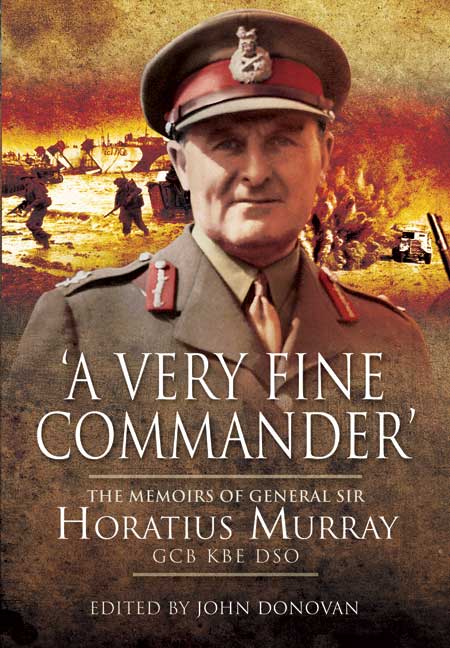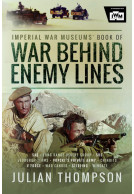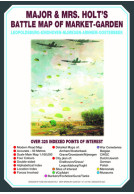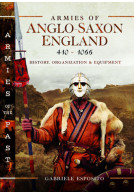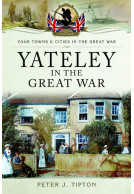A Very Fine Commander (Hardback)
The Memories of General 'Nap' Murray GCB KBE DSO
Imprint: Pen & Sword Military
Pages: 306
ISBN: 9781848843370
Published: 20th October 2010
(click here for international delivery rates)
Order within the next 9 hours, 54 minutes to get your order processed the next working day!
Need a currency converter? Check XE.com for live rates
| Other formats available - Buy the Hardback and get the eBook for free! | Price |
|---|---|
| A Very Fine Commander ePub (3.2 MB) Add to Basket | £4.99 |
The contrast between soldiering in peace and war is well illustrated by ‘Nap’ Murray’s experiences. It took him 16 years to reach the substantive rank of Major in 1938 but by 1944 he was an acting Lieutenant General.
His fascinating memoirs, skilfully edited by his nephew, cover an extraordinary career from young officer service in India, China and Egypt, his experiences with the German Army in 1937 before the dramas of WW2. His accounts of action and injury in the early war years in France, North Africa, Sicily and Normandy, prepare the reader for Murray’s long and distinguished record as a Divisional commander in Italy, Palestine, Catterick and finally the Commonwealth Division in Korea. It was Monty himself who described Murray as ‘A Very Fine Commander’ – praise indeed, a memoir can be very revealing about the character of its author. Entirely free of self-aggrandisement or pride this book leaves the reader unsurprised at the success and popularity of its author.
Horatius Murray (1903-1989) was commissioned into the Cameronians (Scottish Rifles) in 1923. and played football for the Army and excelled at many sports. In 1935, he went to Staff College before training with the German Army in 1937. He commanded the 3rd Battalion The Cameron Highlanders in 1940 before being sent to North Africa where he commanded the 1st Gordon Highlanders. Despite being wounded at El Alamein he commanded no less than four divisions (as recounted in this memoir). After commanding Scottish Command he became C-in-C Allied Forces Northern Europe. After retiring in 1961 he dedicated himself to worthy causes notably as Chairman of the Royal Hospital for Incurables Putney.
The Editor, John Donovan Naps nephew lives in Herefordshire
This book should be on the shelf of every student of soldiering between 1920 and 1960.
The Cameronian Regimental Blog
There is something truly wonderful in this account which comes from the ability to recall things in great detail and the skill to tell a story.
War History Online
The book is easy to review because it is a lovely read and it is impossible not to warm to the author. A man of dignity and bearing, as you would expect of such a character, he oozes charm and sprinkles his account with chunks of sang-froid.
General Sir Horatius Murray may not be a particularly well known commander, but he served at increasingly high rank in many theatres during the Second World War, commanding troops in battle in North Africa, Sicily, Normandy, Italy and Austria, and rising from junior rank to command a battalion, then a brigade and finally a division. His post-war career was
History of War
What makes this autobiography particularly interesting is that Murray isn't one of the better known officers or highest ranked generals, but instead was one of the surprisingly large number of generals who commanded brigades and divisions during the Second World War (hundreds in the British army alone). He was also much closer to the 'norm' than most generals who later produced autobiographies or who have been the subject of biographies. He didn't kick against the system like Wingate or stand out like Montgomery. He enjoyed the social life of the army officer (including hunting, which he defends as a useful bonding exercise for officers), and in some respects resembles the sort of officer who the more 'awkward' men would condemn in their own autobiographies. Despite this he was clearly a very capable commander, rising to the command of a division in Italy in 1944, after commanding a brigade during the Normandy campaign. If he hadn't suffered a serious injury early in his command career in North Africa he may well have risen to higher command during the war, and in the post-war period he reached the rank of full general and was a very senior figure within NATO.
Murray's status gives us a different perspective on the army. People like Alan Brooke or Eisenhower, who feature as colleagues and (at least perceived) equals in many memoirs here appear as somewhat distant figures, rarely encountered and even then only briefly. Montgomery appears more often, as Murray served under him in North Africa and Normandy. Murray started the war as a Major, so we also get to see the earlier years of the war through the eyes of a relatively junior officer,
Murray comes across as a modest man, but a very capable one. He was an excellent observer of events, although sometimes his modesty has forced the editor to add supporting information.
The contract between soldiering in peace and war is well illustrated by ‘Nap’ Murrays experiences. It took him 16 years to reach the rank of Major in 1939 but 6 years later he was Lt. General. This is a first class military memoir of a leader who proved his mettle time and time again
Pennant Magazine
I had heard of General Nap Murray but didn’t know too much about him. This book has been complied by his nephew from papers that he left. The title comes from a Montgomery quote about General Murray.
ARRSE.co.uk
I think it must have been a difficult task to edit the papers because General Murray definitely led a full life, he served from 1921 until 1961. His rise to general started slowly, he was still a Major in 1939 but soon accelerated in World War two, having reached the rank of acting Major General by 1945 (though still only a substantive Major!)
Nap served all over the world, pre-war in Egypt and India, he stared WW2 in a staff appointment in London before going on to command, first a Battalion, then a brigade and finally a Division. He saw action in North Africa, Sicily, Normandy, Italy and Austria. After the war, he was in Palestine during the troubles there, after a brief stop at Catterick, he returned to action as GOC the Commonwealth Division in Korea. He rounded off his career as CinC Scotland before a NATO appointment in charge of Allied Forces, Northern Europe.
His writing is very modest and many of his more glorious deeds he seems to gloss over and they have to be explained in editor’s foot notes. I suppose though to go into more detail more have required a far longer and larger book as he had a long and varied military career. He does not mention his award of a DSO and it is left to an Editors footnote to say that he was awarded one.
The writing style is very free and easy to read, almost informal at times and you definitely get a feel for him as a man and how he was thinking on many things even if only fleetingly. The book flows in a nice chronological order, from early life through to retirement and then after.
He is fairly reserved as to his private life, for example, the first mention his wife to be gets is when he writes that they were going to get a special license to marry before he deployed to Korea. He does go into more detail about personal life during his period as CinC Scotland and CinC Northern Europe.
I would have liked to have read a little bit more about his post military career as well, as the brief descriptions are enough to make one want to know more. He worked with various charities and would appear to have done good work, but again difficult to know exactly what from his very modest writing!
According to the editor the General wrote his memoirs in the 1970’s and then died in 1989 at the DGAA (Distressed Gentlefolk Aid Association) where he had no television, only books, visitor and half a bottle of claret each day(to keep him going), this would seem well in keeping with the modesty shown in his writing.
The photos in the book are mostly of Nap in various parts of the world and are well chosen to reflect the very varied life he lived. They are a mix of photos of him and those that illustrate campaigns he fought in.
As he only retired in 1961, it's more than probably that one or two of the older members may even have served under him.
In summary, I found the book a very personal story of a man who achieved great things, without boasting about them, was knighted for his efforts. You get a good feel for his character and I think it’s a pity he’s not more prominent but that is probably due to the fact that he was not really a self publicist as several of the World War 2 seemed to have been.
The contrast between soldiering in peace and war is illustrated by Murray's experiences; it took him sixteen years to reach the substantive rank of Major in 1938 – by 1944 he was an acting Lieutenant General. His memoirs cover his career from young officer's service in India, dramas of the Second World War.
Britain at War Magazine
So said Field Marshal Montgomery, when General Horatius Murray suggested writing his recollections of a lifetimes service. Indeed, military memoirs can be very hit or miss, usually the latter. Especially when written by a family member or close friend. I’ve got to be honest, I wasn’t too excited about reading this book – the memoirs of a General I had never heard of. But in actual fact, Horatius Murray’s memoirs made for a very interesting read, giving a great insight into the career of a pre-war officer, mid-level command in the Second World War, and then post-war command in Korea, Scottish Command and NATO’s Northern Command in Scandinavia.
Daly History Blog
You would expect somebody called Horatius to have served in the Guards, a dashing Cavalry Regiment or perhaps the Rifles. In fact Murray came from a relatively modest family, and only just manged to afford to go to Sandhurst. Although he performed well there, without sufficient private means he was forced to join a relatively unglamorous unit, the Cameronian Rifles. It shows the differing pace of soldiering in peace and war that from when he was commissioned in 1923 it took Murray until 1938 to become a Major, yet by 1944 he was an acting Major-General. Some of his early years as an officer were spent serving in Egypt, India and China. Interestingly, he also spent several months on attachment with the Germany Army only a couple of years before the Second World War broke out.
Horatius Murray commanded a Gordon Highlanders Battalion at El Alamein, where he was seriously wounded, then recovered in time to resume command in the final days of the Tunisian Campaign. He was then given command of a Brigade in the invasion of Sicily. In late 1943 the 51st Highland Division returned to Britain to take part in Operation Overlord. A follow up Division, the Highlanders landed in Normandy on 7 June 1944. In Normandy the Division performed rather poorly, in Murray’s opinion due to poor leadership and a lack of serious training. At one point Murray refused an order from the Divisional Commander, Major General Bullen-Smith, that he thought was needless and would waste mens lives. The Corps Commander ruled in Murray’s favour, recommended Bullen-Smith’s sacking, which Monty confirmed soon after. This undoubtedly showed great moral courage on Murray’s part. Shortly after landing in Normandy Murray was transferred to Italy to take command of 6th Armoured Division, which he led until the end of the war.
After the war he served as commander of the 1st Division, Director of Personnel at the War Office and commanded the 50th (Northumbrian) Division, a territorial unit based in Catterick. After leaving that post he was selected to command the Commonwealth Division in Korea. Although this came in 1953 after the ceasefire, Murray still commanded British, Australian, Canadian and New Zealand troops in peacekeeping. Murray seems to have been a very modest General, to the point of not even mentioning in his memoirs his DSO and other brave acts – his Nephew added notes in when editing. He seems to have had no airs nor graces. Indeed, when he left command of the 50th Division based at Catterick, the local newspaper reported that he had given the camp a soldiers touch.
Also included are some very revealing ancedotes about King George VI, Queen Elizabeth the Queen Mother, Monty, Eisenhower, Bernard Freyberg VC and Maxwell Taylor. I cannot recall many other books that I picked up with such disinterest, yet finished with such an insight. I enjoyed reading them immsensely.
The contrast between soldiering in peace and war is well illustrated by ‘Nap’ Murray’s experiences. It took him 16 years to reach the substantive rank of Major in 1938 but by 1944 he was an acting Lieutenant General.
TORQUE THE MOTOR BOOKS NEWSLETTER
His fascinating memoirs, skilfully edited by his nephew, cover an extraordinary career from young officer service in India, China and Egypt, his experiences with the German Army in 1937 before the dramas of WW2. His accounts of action and injury in the early war years in France, North Africa, Sicily and Normandy, prepare the reader for Murray’s long and distinguished record as a Divisional commander in Italy, Palestine, Catterick and finally the Commonwealth Division in Korea. It was Monty himself who described Murray as ‘A Very Fine Commander’ – praise indeed, a memoir can be very revealing about the character of its author. Entirely free of self-aggrandisement or pride this book leaves the reader unsurprised at the success and popularity of its author.
'Your memoirs? Nap, whoever do you think is going to read them?' Field Marshal Montgomery apparently asked. Well I have - and I found them most interesting.
Generals.dk
Having been too young for participation in WWI the memoirs of General Murrays career as a junior regimental officer between the wars is interesting as well as his period at the Staff College. Naturally the part of these memoirs that I enjoyed the most is the chapters dealing with Murray's career during WWII, not least because of his opinions and comments about other WWII generals Alanbrooke, Montgomery and Paget. At times I would have liked him to go into a bit more details regarding his military work rather telling amusing anecdotes, though these makes the book an enjoyable read.
5 out of 5 stars
Ned Middleton
It is a curious fact that war often brings out the very best in career servicemen who were otherwise overlooked for promotion with one of the more better-known cases being Walker RN. In this excellently crafted biography of a great soldier, we learn that Horatius Murray took 16 years to the reach the rank of substantive (i.e. permanent) major - which he achieved just as WW2 broke out in Europe, and yet six years later had reached the rank of Lt. General.
Murray's was a career the like of which could never be seen again. Commissioned in 1923, he excelled at several sports and played football for the army. In a riveting biography - skilfully put together by Murray's nephew John Donovan, it is fascinating to read how one man from a bygone age of empire and soldiering could achieve so much and yet so little until the emergence of that career defining war. From his days as a junior officer in India to his command of 1st Gordon Highlanders and being badly wounded at El Alamein, through to his time as a Major General when he commanded no fewer than four divisions - including the Commonwealth division during the Korean War to his promotion to General and even the years thereafter.
Whilst there is no reason why I should have heard of every general who ever served on the British Army, I am, nevertheless, surprised that I had not previously heard of this outstanding officer who retired less than 5 years before I served my own first day in uniform. There is much about this memoirs which will prove useful to soldiers, historians and indeed anyone with an interest in the subject. In my view this is largely because of the lessons to be learned from the man himself.
In retirement, General Murray preferred to foster the young rather than look after the old - one of the main reasons he turned down the appointment of Governor of the Royal Hospital, Chelsea. With that in mind, I shall close this review for the benefit of all those who despair at the "youth of today," by quoting from the General's own final chapter: "I continue to have the greatest confidence in the incoming generations, however much they try to disguise their quality. I saw enough of the teenagers of the 1930's, who played a major part in winning World War Two, to be quite convinced that the young of today, given proper challenges, will be just as good.
Altogether, quite refreshing.
This worthy book, which until recently was hidden away in military boxes not only tells the story of a fine commander – but more importantly it is about a fine man. Brought up in Winchester, Nap Murray chose the profession of arms. He was commissioned into the Cameronians (Scottish Rifles) – perhaps influenced by seeing the Green Jackets in Winchester, pouring down from their barracks at the double and through into the nave of the Cathedral – “like an irresistible avalanche”. Regimental soldiering was the bed-rock of his career. His unfashionable Regiment proved a fertile ground for advancement, producing thirteen Generals who flit through his pages – amongst whom were George Collingwood, and Dick O’Connor.
Charles Baker-Cresswell, Bamburgh 2010
Peacetime soldiering saw very slow promotion. Twelve years after joining he was still eighth in the list of subalterns in his regiment. Service was seen in China (six weeks in a troop ship), Egypt, India. The book is full of fascinating asides and reminders of times past – other ranks in India could afford personal servants who would shave them in bed, and yet (- shades of the Mutiny) the Indian Army was not even trusted with a Regiment of Artillery.
Staff College trained and a German speaker he describes an attachment to the German Army in 1937 when their army of thirty six divisions was secretly being triplicated, probably a unique account by an English General.
Everyone needs luck – and he got it when, in 1940 he was posted to the staff of the 3rd Division, commanded by Bernard Montgomery. Nap Murray had ability as well as luck – and he caught Monty’s eye. This book is worth the money just for his story about Monty’s marvellous Irish ADC, who halted his General’s monologue in the mess by a quiet comment – “Sir, it is obvious that you have never hunted”.
After Storeys Gate HQ with the much-admired General Sir Bernard Paget – “the man who forged the weapon for the invasion of Normandy so splendidly” – he was given command of the 1st Battalion Gordon Highlanders and sent to Suez in 1942. From there with nineteen years of service behind him and never having been in action, he led his Battalion into battle at Alamein. Within 24 hours he was seriously wounded by a shell splinter which nearly cost him his arm. He recovered sufficiently to rejoin his Battalion and promotion swiftly followed, first as a Divisional staff officer then commanding a Brigade in the 51st Highland Division and witnessing the subsequent surrender of a quarter of a million Germans in Tunisia.
He waded ashore in Sicily and won his DSO in bitter fighting against good German troops. Back in England and preparing to lead his Brigade on D+1, he well notes the deficiencies of the veterans of the desert and Sicily. The Home Army had been training for four years and was at a higher level of excellence and dash. The veterans were thought to know all the answers but were becoming burnt out and were insufficiently aware of the tactical challenges to come.
He was involved in desperate fighting in Normandy where his Divisional commander was eventually sent home by Monty. Murray had to show his character and independence when he challenged an order to attack. His decision was upheld by the Army commander.
Luck came to him again when Major General Templer having been sent to command 6 Armoured Division in Italy, was struck by a grand piano and seriously injured – what a story! ‘Nap’ was given that Division. More hard fighting and a graphic account of the crossing of the Po with the New Zealand Division under its irrepressible leader, General Bernard Freyberg – he of the VC and 3 DSOs. Read of the surrender of the Cossacks and the race to Venice and Trieste.
In January 1945 he commanded X111 Corps as Acting Lieutenant General – whilst in the army list still a major in the Cameron Highlanders. With the final German surrender, we are pleased to hear “-we made a little hay”. “The purple patch of 1945 was probably the most exciting and fulfilling year of my whole service.” Who would grudge him that fruit?
This is the portrait of a wise and humane man. The people who served under him were surely lucky. This book – well edited by his nephew – should grace the shelves not just of military buffs but of all those people who owe a debt to the service men and women who saved us from the triumph of the Third Reich – and that is all of us. Get it, and be enriched.
Horatius Murray (1903-1989) was commissioned into the Cameronians (Scottish Rifles) in 1923. and played football for the Army and excelled at many sports. In 1935, he went to Staff College before training with the German Army in 1937. He commanded the 3rd Battalion The Cameron Highlanders in 1940 before being sent to North Africa where he commanded the 1st Gordon Highlanders. Despite being wounded at El Alamein he commanded no less than four divisions (as recounted in this memoir). After commanding Scottish Command he became C-in-C Allied Forces Northern Europe. After retiring in 1961 he dedicated himself to worthy causes notably as Chairman of the Royal Hospital for Incurables Putney.
Spartacus Educational







